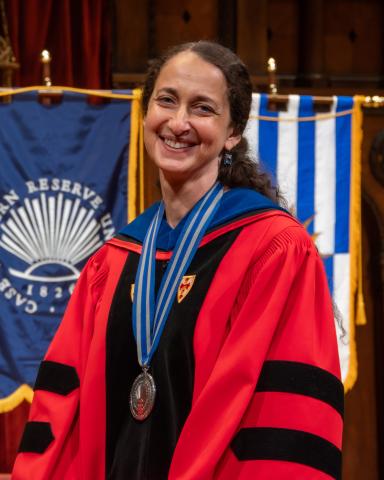Elina Gertsman’s interest in medieval art history may have developed, as she says, “simply by osmosis.”
Growing up in Tallinn, Estonia, Gertsman was constantly surrounded by what she calls a “preternatural” beauty of this medieval town. As an art student she painted on its streets; when she was a kid, her grandfather would buy her ice cream from a cafe perched on a hill near a 13th-century church.
That church, in fact, would become pivotal to her career: it was home to Bernt Notke’s danse macabre painting, which, decades later, became a subject of Gertsman’s first book, The Dance of Death in the Middle Ages.
The book went on to win an award for the best first monograph in medieval studies—catapulting Gertsman into an accolade-filled career, which includes a Guggenheim Fellowship and induction as Fellow to the Medieval Academy of America.
Her latest: the title of Distinguished University Professor, one of Case Western Reserve’s highest honors for full-time, tenured faculty with exceptional records of research, scholarship, teaching and service. Gertsman, professor of medieval art, Andrew W. Mellon Professor of the Humanities and acting chair for the Department of Art History and Art, will receive the honor during fall convocation Thursday, Sept. 7, at 4:45 p.m. at the Maltz Performing Arts Center.
Gertsman’s selection as a Distinguished University Professor comes as little surprise to those in her field; colleagues at institutions from coast to coast wrote letters supporting her nomination.
“The distinctiveness of Dr. Gertsman’s scholarship,” one nominator wrote, “lies in just this ability to challenge boundaries: to push beyond the usual research areas, methods, resources, and solutions to find pathbreaking answers to critical questions, even (perhaps especially) those that other scholars hadn’t yet thought to ask.”
“The most creative and distinguished American art historian working today, with an international reputation to match,” as another nominator described her, Gertsman has delivered numerous talks, plenaries, and invited lectures globally. She’s authored and edited 13 books, with several more in the works.
Her most recent, The Absent Image, which she dedicated to her late father, won some of the highest honors in the field of medieval studies (the Otto Gründler Prize) and across the discipline of art history (the Charles Rufus Morey Book Award).
“This book was extremely hard to write—it stands at the nexus of truly interdisciplinary research, and it demanded that I read … not only (often untranslated) works on medieval philosophy and theology, but also those on medieval cosmology and mathematics,” Gertsman explained.
A prolific scholar, Gertsman is also devoted to her students: She earned the university’s John S. Diekhoff awards for teaching and mentoring, as well as the Medieval Academy of America’s award for excellence in teaching.
As CWRU Interim Provost Joy K. Ward wrote in her nomination letter, Gertsman “has drawn exceptionally gifted graduate students to Case Western Reserve and has almost single-handedly transformed the graduate program in art history.”
Gertsman credits the university for supporting her intellectual curiosity and scholarly identity—which CWRU, in turn, recognized by naming her a history-making Distinguished University Professor: Gertsman is the youngest, the first from the Department of Art History and Art, and only the second woman from the humanities to earn the title.
“It is rare for a professor to be the world’s most distinguished scholar in their field,” Ward wrote, “but I, as well as many others within the College of Arts and Sciences, believe this is the case with Professor Elina Gertsman.”


